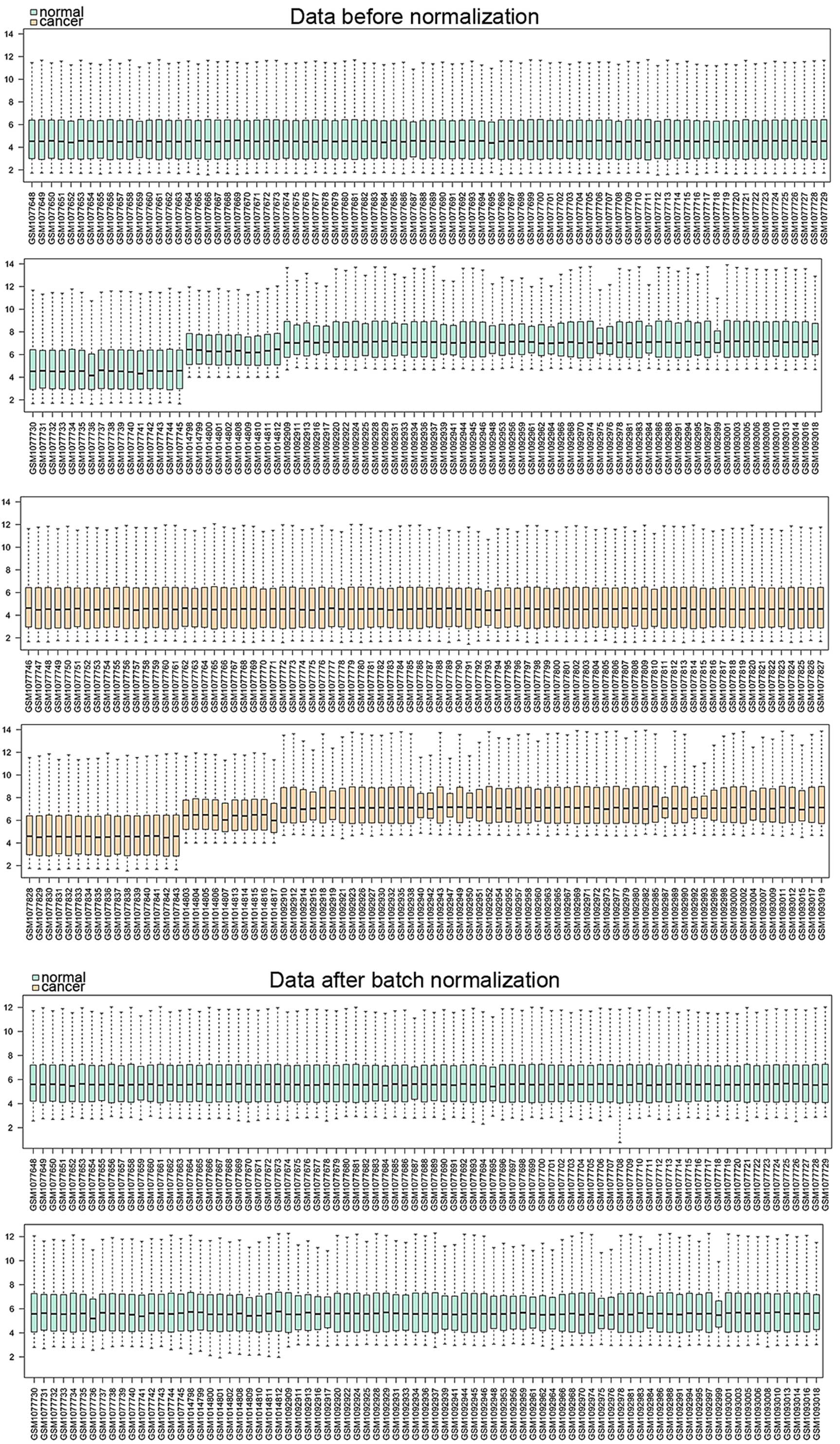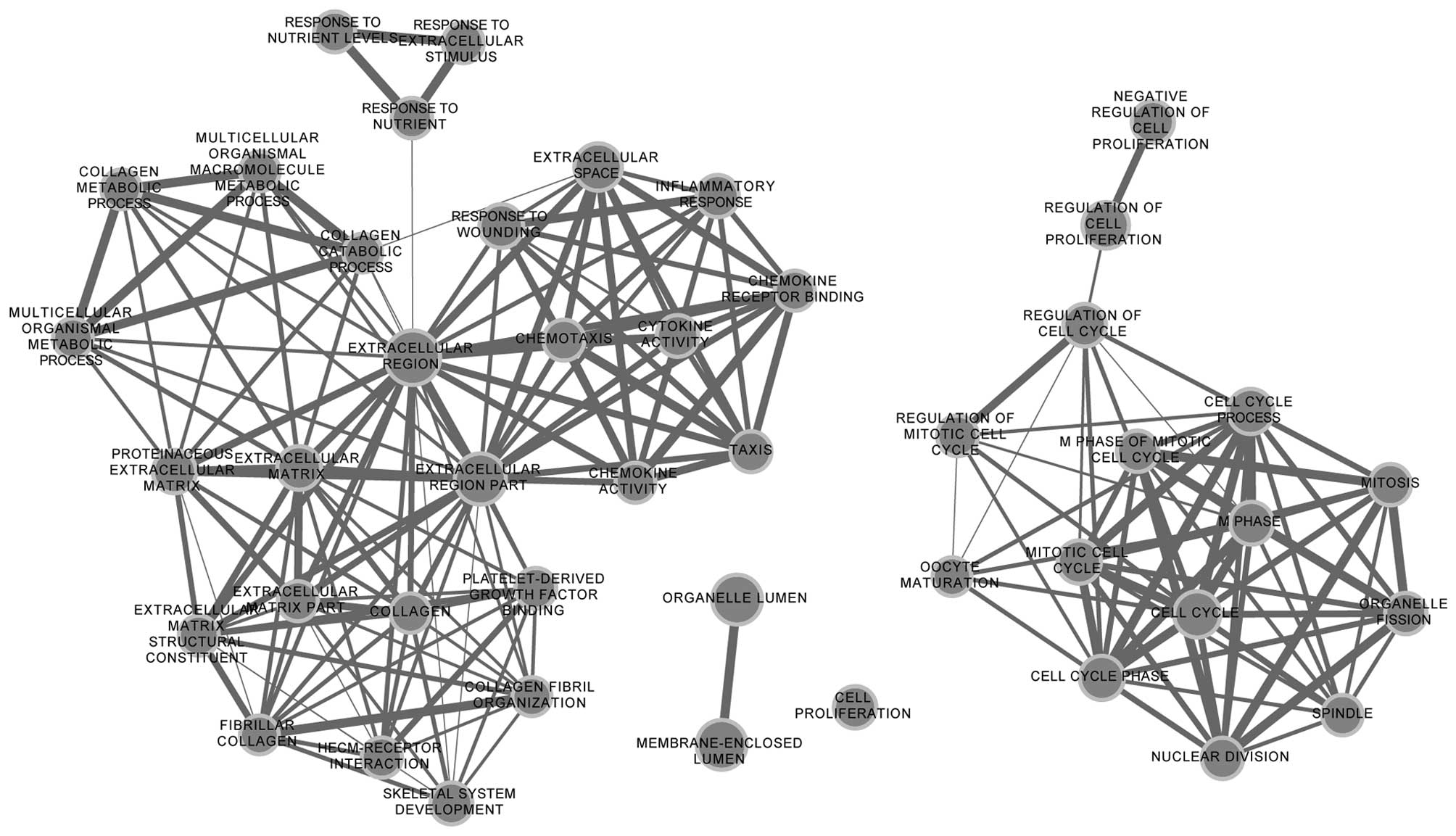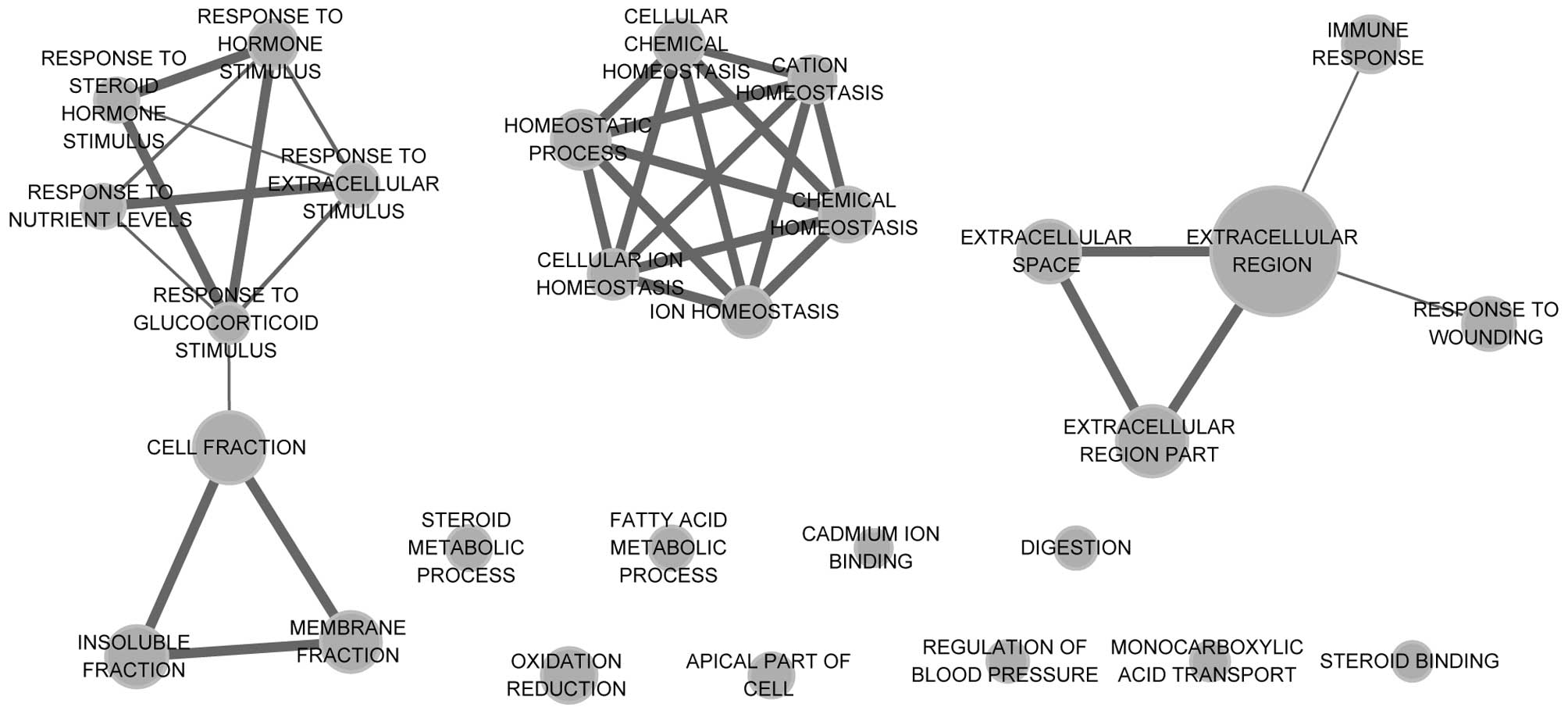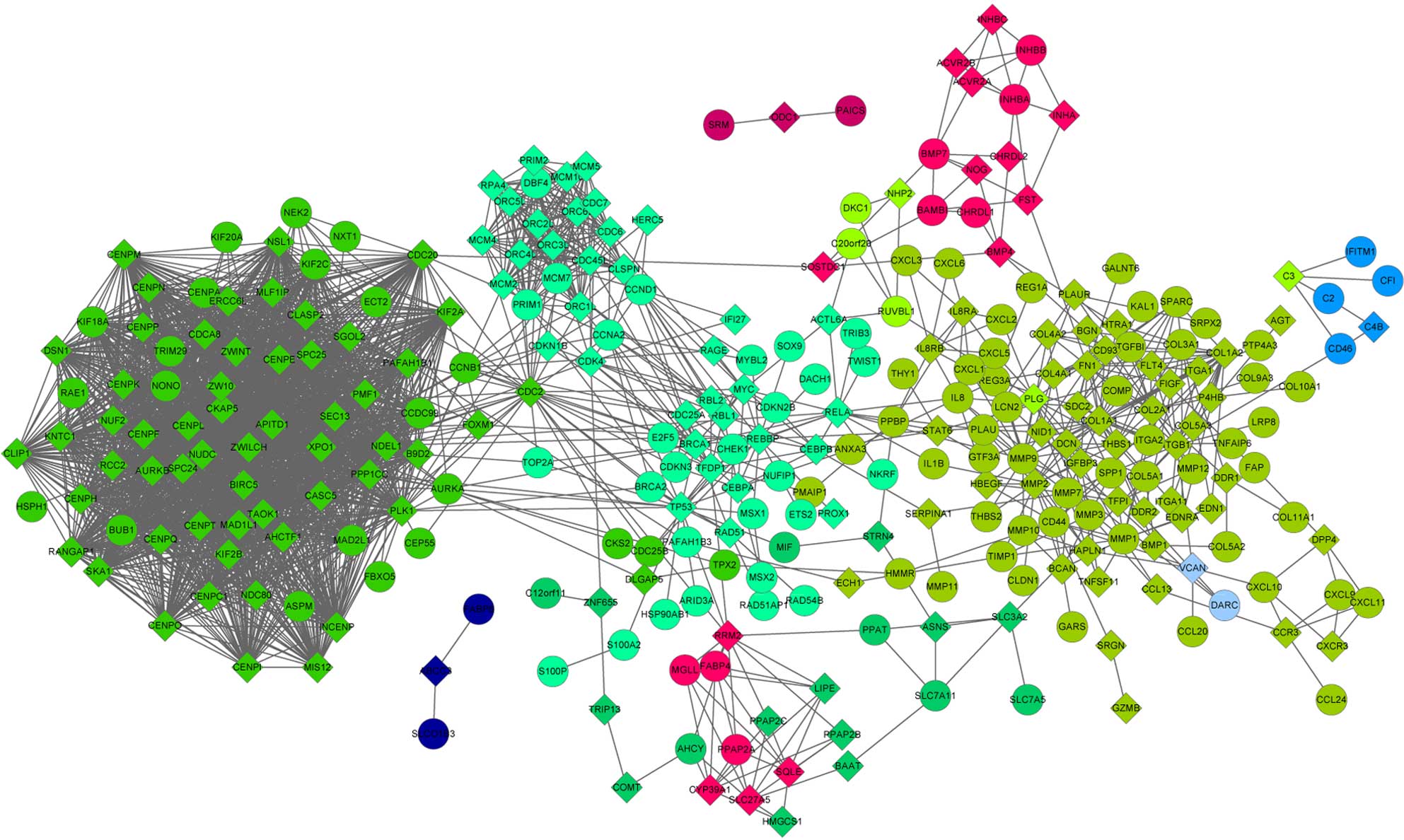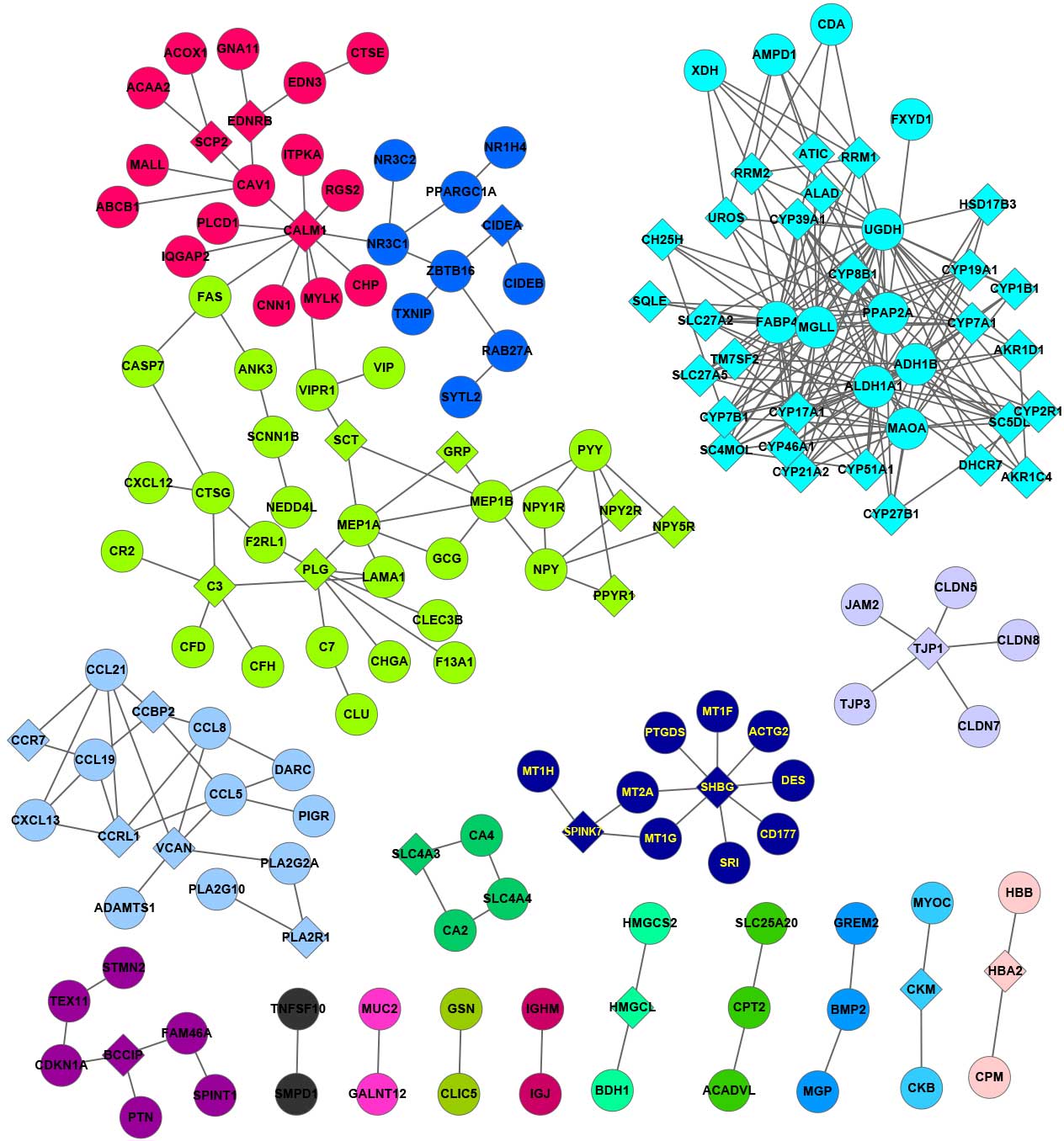|
1
|
Kemp Z, Thirlwell C, Sieber O, Silver A
and Tomlinson I: An update on the genetics of colorectal cancer.
Hum Mol Genet. 13:R177–R185. 2004. View Article : Google Scholar : PubMed/NCBI
|
|
2
|
Siegel R, DeSantis C and Jemal A:
Colorectal cancer statistics, 2014. CA Cancer J Clin. 64:104–117.
2014. View Article : Google Scholar : PubMed/NCBI
|
|
3
|
Grady WM and Carethers JM: Genomic and
epigenetic instability in colorectal cancer pathogenesis.
Gastroenterology. 135:1079–1099. 2008. View Article : Google Scholar : PubMed/NCBI
|
|
4
|
Hatzivassiliou G, Song K, Yen I,
Brandhuber BJ, Anderson DJ, Alvarado R, Ludlam MJ, Stokoe D, Gloor
SL, Vigers G, et al: RAF inhibitors prime wild-type RAF to activate
the MAPK pathway and enhance growth. Nature. 464:431–435. 2010.
View Article : Google Scholar : PubMed/NCBI
|
|
5
|
Bellam N and Pasche B: Tgf-beta signaling
alterations and colon cancer. Cancer Treat Res. 155:85–103. 2010.
View Article : Google Scholar : PubMed/NCBI
|
|
6
|
Chang SC, Lin JK, Yang SH, Wang HS, Li AF
and Chi CW: Relationship between genetic alterations and prognosis
in sporadic colorectal cancer. Int J Cancer. 118:1721–1727. 2006.
View Article : Google Scholar : PubMed/NCBI
|
|
7
|
Harpaz N and Polydorides AD: Colorectal
dysplasia in chronic inflammatory bowel disease: Pathology,
clinical implications and pathogenesis. Arch Pathol Lab Med.
134:876–895. 2010.PubMed/NCBI
|
|
8
|
Zisman TL and Rubin DT: Colorectal cancer
and dysplasia in inflammatory bowel disease. World J Gastroenterol.
14:2662–2669. 2008. View Article : Google Scholar : PubMed/NCBI
|
|
9
|
Wang D and Dubois RN: Prostaglandins and
cancer. Gut. 55:115–122. 2006. View Article : Google Scholar : PubMed/NCBI
|
|
10
|
Eisinger AL, Prescott SM, Jones DA and
Stafforini DM: The role of cyclooxygenase-2 and prostaglandins in
colon cancer. Prostaglandins Other Lipid Mediat. 82:147–154. 2007.
View Article : Google Scholar : PubMed/NCBI
|
|
11
|
Doherty GA, Byrne SM, Molloy ES, Malhotra
V, Austin SC, Kay EW, Murray FE and Fitzgerald DJ: Proneoplastic
effects of PGE2 mediated by EP4 receptor in colorectal cancer. BMC
Cancer. 9:2072009. View Article : Google Scholar : PubMed/NCBI
|
|
12
|
Sanz-Pamplona R, Berenguer A, Cordero D,
Molleví DG, Crous-Bou M, Sole X, Paré-Brunet L, Guino E, Salazar R,
Santos C, et al: Aberrant gene expression in mucosa adjacent to
tumor reveals a molecular crosstalk in colon cancer. Mol Cancer.
13:462014. View Article : Google Scholar : PubMed/NCBI
|
|
13
|
Lin G, He X, Ji H, Shi L, Davis RW and
Zhong S: Reproducibility probability score-incorporating
measurement variability across laboratories for gene selection. Nat
Biotechnol. 24:1476–1477. 2006. View Article : Google Scholar : PubMed/NCBI
|
|
14
|
Ryan BM, Zanetti KA, Robles AI, Schetter
AJ, Goodman J, Hayes RB, Huang WY, Gunter MJ, Yeager M, Burdette L,
et al: Germline variation in NCF4, an innate immunity gene, is
associated with an increased risk of colorectal cancer. Int J
Cancer. 134:1399–1407. 2014. View Article : Google Scholar : PubMed/NCBI
|
|
15
|
Leek JT, Johnson WE, Parker HS, Fertig EJ,
Jaffe AE and Storey JD: Package ‘SVA’: Surrogate Variable Analysis.
R package version 3. 2013, https://www.bioconductor.org/packages/devel/bioc/manuals/sva/man/sva.pdf
|
|
16
|
Bolstad BM: Package ‘preprocessCore’: A
collection of pre-processing functions. R package version 1. 2013,
https://www.bioconductor.org/packages/devel/bioc/manuals/preprocessCore/man/preprocessCore.pdf
|
|
17
|
Smyth GK: Limma: Linear models for
microarray dataBioinformatics and computational biology solutions
using R and Bioconductor. Springer; NY: pp. 397–420. 2005,
View Article : Google Scholar
|
|
18
|
Ferreira JA: The Benjamini-Hochberg method
in the case of discrete test statistics. Int J Biostat. 3:112007.
View Article : Google Scholar
|
|
19
|
Dennis G Jr, Sherman BT, Hosack DA, Yang
J, Gao W, Lane HC and Lempicki RA: DAVID: Database for annotation,
visualization, and integrated discovery. Genome Biol. 4:P32003.
View Article : Google Scholar : PubMed/NCBI
|
|
20
|
Ashburner M, Ball CA, Blake JA, Botstein
D, Butler H, Cherry JM, Davis AP, Dolinski K, Dwight SS, Eppig JT,
et al: Gene ontology: Tool for the unification of biology. The Gene
Ontology Consortium. Nat Genet. 25:25–29. 2000. View Article : Google Scholar : PubMed/NCBI
|
|
21
|
Kanehisa M and Goto S: KEGG: Kyoto
encyclopedia of genes and genomes. Nucleic Acids Res. 28:27–30.
2000. View Article : Google Scholar : PubMed/NCBI
|
|
22
|
Merico D, Isserlin R and Bader GD:
Visualizing gene-set enrichment results using the Cytoscape plug-in
enrichment map. Methods Mol Biol. 781:257–277. 2011. View Article : Google Scholar : PubMed/NCBI
|
|
23
|
Joshi-Tope G, Gillespie M, Vastrik I,
D'Eustachio P, Schmidt E, de Bono B, Jassal B, Gopinath GR, Wu GR,
Matthews L, et al: Reactome: A knowledgebase of biological
pathways. Nucleic Acid Res. 33:D428–D432. 2005. View Article : Google Scholar : PubMed/NCBI
|
|
24
|
Matthews L, Gopinath G, Gillespie M, Caudy
M, Croft D, de Bono B, Garapati P, Hemish J, Hermjakob H, Jassal B,
et al: Reactome knowledgebase of human biological pathways and
processes. Nucleic Acid Res. 37:D619–D622. 2009. View Article : Google Scholar : PubMed/NCBI
|
|
25
|
Prasad TK, Goel R, Kandasamy K,
Keerthikumar S, Kumar S, Mathivanan S, Telikicherla D, Raju R,
Shafreen B, Venugopal A, et al: Human protein reference
database-2009 update. Nucleic Acid Res. 37:D767–D772. 2009.
View Article : Google Scholar : PubMed/NCBI
|
|
26
|
Somwar R, Erdjument-Bromage H, Larsson E,
Shum D, Lockwood WW, Yang G, Sander C, Ouerfelli O, Tempst PJ,
Djaballah H and Varmus HE: Superoxide dismutase 1 (SOD1) is a
target for a small molecule identified in a screen for inhibitors
of the growth of lung adenocarcinoma cell lines. Proc Natl Acad Sci
USA. 108:16375–16380. 2011. View Article : Google Scholar : PubMed/NCBI
|
|
27
|
Schaefer CF, Anthony K, Krupa S, Buchoff
J, Day M, Hannay T and Buetow KH: PID: The pathway interaction
database. Nucleic Acid Res. 37:D674–D679. 2009. View Article : Google Scholar : PubMed/NCBI
|
|
28
|
Kohl M, Wiese S and Warscheid B:
Cytoscape: software for visualization and analysis of biological
networks. Methods Mol Biol. 696:291–303. 2011. View Article : Google Scholar : PubMed/NCBI
|
|
29
|
De Craene B and Berx G: Regulatory
networks defining EMT during cancer initiation and progression. Nat
Rev Cancer. 13:97–110. 2013. View
Article : Google Scholar : PubMed/NCBI
|
|
30
|
Valdes F, Alvarez AM, Locascio A, Vega S,
Herrera B, Fernández M, Benito M, Nieto MA and Fabregat I: The
epithelial mesenchymal transition confers resistance to the
apoptotic effects of transforming growth factor Beta in fetal rat
hepatocytes. Mol Cancer Res. 1:68–78. 2002.PubMed/NCBI
|
|
31
|
Ansieau S, Bastid J, Doreau A, Morel AP,
Bouchet BP, Thomas C, Fauvet F, Puisieux I, Doglioni C, Piccinin S,
et al: Induction of EMT by twist proteins as a collateral effect of
tumor-promoting inactivation of premature senescence. Cancer Cell.
14:79–89. 2008. View Article : Google Scholar : PubMed/NCBI
|
|
32
|
Mani SA, Guo W, Liao MJ, Eaton EN, Ayyanan
A, Zhou AY, Brooks M, Reinhard F, Zhang CC, Shipitsin M, et al: The
epithelial-mesenchymal transition generates cells with properties
of stem cells. Cell. 133:704–715. 2008. View Article : Google Scholar : PubMed/NCBI
|
|
33
|
Roy R, Yang J and Moses MA: Matrix
metalloproteinases as novel biomarkers and potential therapeutic
targets in human cancer. J Clin Oncol. 27:5287–5297. 2009.
View Article : Google Scholar : PubMed/NCBI
|
|
34
|
Turpeenniemi-Hujanen T: Gelatinases (MMP-2
and −9) and their natural inhibitors as prognostic indicators in
solid cancers. Biochimie. 87:287–297. 2005. View Article : Google Scholar : PubMed/NCBI
|
|
35
|
Deryugina EI and Quigley JP: Pleiotropic
roles of matrix metalloproteinases in tumor angiogenesis:
Contrasting, overlapping and compensatory functions. Biochim
Biophys Acta. 1803:103–120. 2010. View Article : Google Scholar : PubMed/NCBI
|
|
36
|
Gialeli C, Theocharis AD and Karamanos NK:
Roles of matrix metalloproteinases in cancer progression and their
pharmacological targeting. FEBS J. 278:16–27. 2011. View Article : Google Scholar : PubMed/NCBI
|
|
37
|
Carmeliet P and Jain RK: Molecular
mechanisms and clinical applications of angiogenesis. Nature.
473:298–307. 2011. View Article : Google Scholar : PubMed/NCBI
|
|
38
|
Viola M, Vigetti D, Genasetti A, Rizzi M,
Karousou E, Moretto P, Clerici M, Bartolini B, Pallotti F, De Luca
G and Passi A: Molecular control of the hyaluronan biosynthesis.
Connect Tissue Res. 49:111–114. 2008. View Article : Google Scholar : PubMed/NCBI
|
|
39
|
Huang D, Casale GP, Tian J, Lele SM,
Pisarev VM, Simpson MA and Hemstreet GP III: Udp-glucose
dehydrogenase as a novel field-specific candidate biomarker of
prostate cancer. Int J Cancer. 126:315–327. 2010. View Article : Google Scholar : PubMed/NCBI
|
|
40
|
Chen Y, Koppaka V, Thompson DC and
Vasiliou V: Focus on molecules: ALDH1A1: From lens and corneal
crystallin to stem cell marker. Exp Eye Res. 102:105–106. 2012.
View Article : Google Scholar : PubMed/NCBI
|
|
41
|
Kiefer FW, Orasanu G, Nallamshetty S,
Brown JD, Wang H, Luger P, Qi NR, Burant CF, Duester G and Plutzky
J: Retinaldehyde dehydrogenase 1 coordinates hepatic
gluconeogenesis and lipid metabolism. Endocrinology. 153:3089–3099.
2012. View Article : Google Scholar : PubMed/NCBI
|
|
42
|
Wootan MG, Bernlohr DA and Storch J:
Mechanism of fluorescent fatty acid transfer from adipocyte fatty
acid binding protein to membranes. Biochemistry. 32:8622–8627.
1993. View Article : Google Scholar : PubMed/NCBI
|
|
43
|
Karakas SE, Almario RU and Kim K: Serum
fatty acid binding protein 4, free fatty acids, and metabolic risk
markers. Metabolism. 58:1002–1007. 2009. View Article : Google Scholar : PubMed/NCBI
|
|
44
|
Long JZ and Cravatt BF: The metabolic
serine hydrolases and their functions in mammalian physiology and
disease. Chem Rev. 111:6022–6063. 2011. View Article : Google Scholar : PubMed/NCBI
|
|
45
|
Nomura DK, Long JZ, Niessen S, Hoover HS,
Ng SW and Cravatt BF: Monoacylglycerol lipase regulates a fatty
acid network that promotes cancer pathogenesis. Cell. 140:49–61.
2010. View Article : Google Scholar : PubMed/NCBI
|



